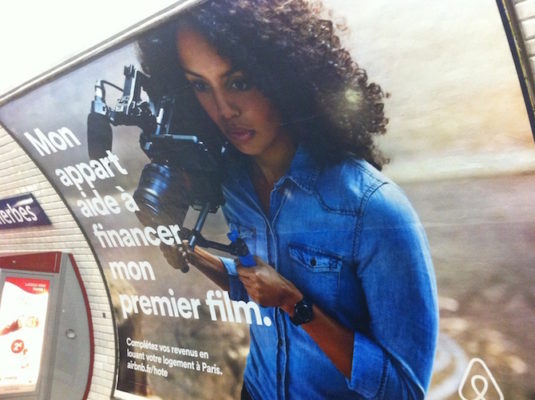Search
To search for an exact match, type the word or phrase you want in quotation marks.
A*DESK has been offering since 2002 contents about criticism and contemporary art. A*DESK has become consolidated thanks to all those who have believed in the project, all those who have followed us, debating, participating and collaborating. Many people have collaborated with A*DESK, and continue to do so. Their efforts, knowledge and belief in the project are what make it grow internationally. At A*DESK we have also generated work for over one hundred professionals in culture, from small collaborations with reviews and classes, to more prolonged and intense collaborations.
At A*DESK we believe in the need for free and universal access to culture and knowledge. We want to carry on being independent, remaining open to more ideas and opinions. If you believe in A*DESK, we need your backing to be able to continue. You can now participate in the project by supporting it. You can choose how much you want to contribute to the project.
You can decide how much you want to bring to the project.

Airbnb, a communal website where users can offer their homes or look for accommodation in private homes for short stays, at the beginning of autumn launched their new advertising campaign in France. Superimposed on to fashionable young people, phrases such as; “my apartment pays for my shoe collection”, “thanks to my guest room, I bought a vintage motorbike”, or even “my flat helped me to finance my start-up” announce the advantages of making your home available to the public at large. If in previous campaigns the company had targeted the tourist, or more specifically the traveller, with slogans eulogised that staying in private homes was part of a more “authentic” experience, closer to the “local” and less prefabricated. On this occasion, the advertisements are directed at the host that will provide this unique, special experience and exploit it. In these advertisements, the house stops being a home to become a place of economic activity.
Although this is nothing new, lately we have witnessed a proliferation of topics related to the domestic in culture, be it as the point of departure for artistic projects or as a spatial context in which different cultural proposals, from exhibitions to concerts, take place. The first time I attended an exhibition in a private home was in Bremen, within the framework of the project Der vierte Raum (“the fourth room”. It was a shared flat in which one of the rooms was used as a space for artistic research while its tenant was abroad on a student exchange. In this case, the spatial framework determined the nature of the proposals that were presented during the project: all site specific and taking the domestic dimension of the space as their theme.
There are equally cultural events that aren’t conditioned sine qua non to take place in somewhere destined for a home but despite this still do. The reasons proffered to justify these other proposals are often related to the experience of the user, in other words, allowing a more intimate and enhanced reception of the work presented. Although for some there is also an intention of institutional critique, establishing themselves as independent spaces, or historical ones, in allusion to the French “literary salons” of the 18th Century and other similar ones. Everything resumes into a cult of the mundane, the “entre-soi” bourgeois that has penetrated the cultural elites that are no longer necessarily economic elites, thanks to years of neoliberal discourse.
In his article Notes on the Exploitation of Poor Artists[[Hans Abbing: “Notes on the Exploitation of Poor Artists”, en V. V. A. A.: Joy Forever. The political economy of social creativity, Free/Slow University of Warsaw, 2011, pp. 83-100 (http://mayflybooks.org/wp-content/uploads/2014/12/9781906948191-web.pdf)]], Hans Abbing demonstrates that the exploitation of poor artists is strictly an internal issue in the way the art world functions (one it has no interest in resolving). He analyses the causes and strategies that contribute to the perpetuation of a system that favours only an elite. Abbing sees a correlation between the democratisation of education and the idea of authenticity in the post-war period that has directly affected art: if we can all be authentic, we can all be artists, and may the best man win. In this way, bolstered by the neoliberal theory that extols entrepreneurship and “be your own boss”, the economy of art (and the cultural industries in general) counts on the consent of the artists to promote their own exploitation. They work for very little or even for free, given that the main objective is the accumulation of symbolic capital that, if all goes well, will later proportion professional, remunerated opportunities.
The large majority of artistic projects that use a home for their presentations are promoted by young people or those at the start of their career. Traditionally they are artists and music bands making their debut in their own studio or with concerts in dives or bars for a small public, something that serves as an apprenticeship and for gaining “on the road” experience. It’s worth adding that the proliferation of this type of presentations in private flats is tied to the boom in the cultural industry of the profession of the mediator, in the form of a programmer or curator, for which opportunities for “trial runs” with minimal risk are less numerous. The house, the guest room, or even the corridor, become in this way places for professional activity.
Hans Abbing also mentions in his text the (much theorised and explored in art) lack of a clear distinction between work and leisure in the life of the freelancer. Yes, exhibition openings, book presentations, public readings, and the like are social events, but for cultural professionals, they are above all spaces for networking, spaces to establish and maintain a network of contacts within the world of culture. If this is so in public spaces (museums, art centres, galleries, foundations…), one doesn’t have to be very creative to imagine the nature of one of these gatherings in a place out of necessity smaller and with a more reduced public. Particularly in the small and medium-sized cities, talking here of the Spanish and European context, the social circles arising within these spaces often overlap, which gives rise to an endogamy in the ambit of art that can be profitable for some and very exclusive for others.
Two American researchers specialising in marketing and consumer studies published in 2011, in the Journal of Consumer Research[[Zeynep Arsel & Craig J.Thompson: “Demythologizing Consumption Practices: How Consumers Protect Their Field-Dependent Identity Investments from Devaluating Marketplace Myths”, en Journal of Consumer Research, vol. 37, nº5 (febrero 2011), Oxford University Press, pp. 791-806]], a piece that analysed the strategies of distinction that a certain type of consumer uses to protect their position in a specific field, in this case, the indie. Arsel and Thompson demonstrated that the consumers of indie culture who considered themselves “authentic” sought to differentiate themselves within this niche market once certain practices became mainstream. Based on the ideas and examples given in their work we could make the analogy and conclude that the boom of events of a small format in spaces normally destined to private life forms part of a strategy of distinction. That of the cultural elites wanting to preserve their superior position in a cultural ambit that over the last few decades has become more democratic, or at least in theory.
Numerous examples demonstrate that in the world of culture and in particular in visual art, contacts are a decisive part of professional advancement. For this reason, it’s no wonder that the neoliberal discourse that extols the figure of the entrepreneur as an adventuring, creative, and daring person has worked its way into the art scene whereby the presentation of art projects in private homes are seen as a trampoline to professional success. So, artistic projects are presented to a reduced, specialist, and complicit public, in a private flat much as they would be presented in a gallery or a centre designed for exhibitions because in reality what counts is the mundane social event that enables the guest to emerge as a professional and her peers to be in contact and reinforce their personal networks. Suddenly the idea that your apartment enables you to finance your first film seems less outlandish.

Glòria Guso is an art historian and a researcher in the social sciences. She was born in the periphery of Barcelona but lives in Paris and her second home is Germany. For her PhD thesis in sociology she studies the international mobility of the visual arts professionals. She writes, coordinates, edits, documents and criticizes.
"A desk is a dangerous place from which to watch the world" (John Le Carré)